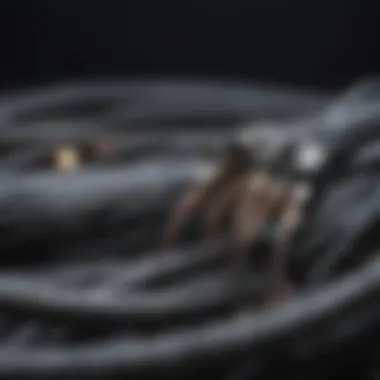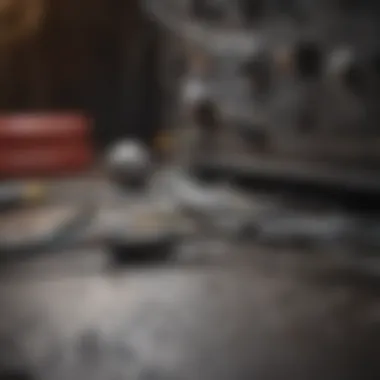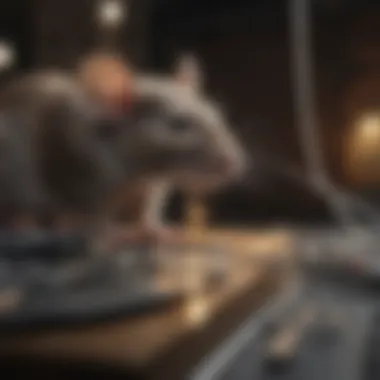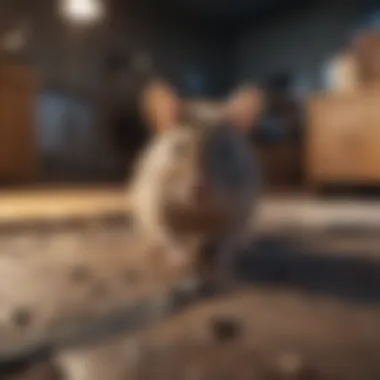Repairing Wires Chewed by Mice: Expert Strategies


Intro
Rodent damage, particularly caused by mice, can lead to significant hazards in electrical systems. Homeowners and business operators must consider how risks associated with chewed wires can impact their safety and the integrity of their properties. This comprehensive guide details effective techniques for identifying and repairing damaged wires. It encompasses the tools necessary, safety precautions to observe, and actionable long-term prevention measures against future infestations. Such insights are crucial for enabling readers to safeguard their environments and ensure safety in electrical installations.
Overview of Repair Needs
Repairing wires chewed by mice involves a systematic approach to assessment and remediation. Managing electrical problems promptly is essential, as delayed reactions can exacerbate risks. Understanding the baseline of potential damage can arm you with knowledge so you can tackle repairs more efficiently.
Common types of wires affected include:
- Electrical wiring
- Phone lines
- Data cables
Once you identify the wires at risk, the following considerations become important:
- Extent of the damage: Minor nicks can sometimes be repaired with tape, whereas more significant bites may require replacements.
- Safety caution: Before undertaking any repair work, ensure power sources are turned off to prevent electrical shock.
Overall, the interpretation and application of instruction regarding repairs will form the core aspects of the guide. These sections laid out in a structured manner aim to provide clarity in navigating through an issue many face but few properly address.
Understanding the Problem
Understanding the issue of wire damage caused by mice is critical for homeowners and business operators alike. Mice do not chew on wires from an aesthetic perspective. Their need stems from instinctual behavior and physical growth requirements. By comprehending this behavior, individuals can take proactive measures to protect their spaces.
Why Mice Chew Wires
Mice have ever-growing teeth that need to be worn down. The chewing instinct is natural and compulsion for them. Wires, often made of plastic insulation and metals, may appear attractive due to their texture and ease of access. This mechanical inclination places electrical wiring at serious risk, ranging from minor inconveniences to major hazards. Understanding the reasons helps in determining preventive strategies.
Common Signs of Wire Damage
Detecting wire damage early is crucial. A few common signs can indicate that something might be wrong:
- Visible Bite Marks: Close inspection can reveal chew marks on the wires.
- Discoloration: Wires may lose their glossy finish or show signs of exposure.
- Unusual Smells: Overheating wires give off a burning smell. Any potentially hazardous scent shouldn’t be ignored.
- Electrical Failures: Flickering lights or unexpected outages may indicate damaged wires.
Regular circuits checks can foster quick detection of any damaging signs. Ignoring these signs can lead to more severe issues like fire hazards, not to mention costly repairs or replacements.
Potential Risks of Damaged Wires
Damage to electrical wires from chewed insulation exposes parts to risk. The primary dangers include:
- Electric Shock: Unprotected wires can lead to serious electric shocks for anyone handling it.
- Electrical Fires: Exposed wiring is a substantial fire risk, able to ignite nearby materials instantly.
- System Downtime: Damaged wires can render devices inoperable, affecting business and personal efficiency.
- Escalating Repair Costs: Damage might necessitate professional repairs or replacements, which can be expensive.
It's wise to prioritize immediate responses to wire damages to mitigate these hazards.
Early detection and prompt repair can significantly increase safety and system reliability.
The next section, Tools and Materials Needed, will detail what one must have in hand to tackle repairs successfully.
Tools and Materials Needed


Understanding the importance of the right tools and materials is crucial when fixing wires chewed by mice. Having essential gear ensures that the repair process is efficient and effective. Using unsuitable tools or materials can lead to inadequate repairs, causing possible future complications. The right setup will make the maintenance simpler and keep electrical systems operational, enhancing safety in residences and workplaces.
Essential Tools for Repairs
When addressing the issue of chewed wires, selecting the proper tools is fundamental. Here is a list of the essential tools you will need to effectively restore any damage caused by rodents:
- Wire Cutters: This tool is essential for cutting away the damaged segment of wiring cleanly.
- Wire Stripper: You will need a stripper to expose the copper core after removing the outer insulation. This part is critical for making a solid electrical connection.
- Soldering Iron: Soldering is sometimes necessary for connecting new wires or repaired ends safely. A good-quality soldering iron will help make these connections smooth and permanent.
- Heat Shrink Tubing: Ideal for insulation, this material covers reconnected areas, protecting them from moisture or further damage.
- Electrical Tape: A readily available option for insulating repairs, but it may not provide as sturdy protections as heat shrink tubing.
Having these items at hand before commencing the repair will streamline the process.
Materials for Effective Repairs
Outside of tools, various materials play significant roles in effective wire repair. It is critical not only to consider the type of wire but also the materials you’ll employ in returning it to a functional state:
- Replacement Wires: If damage is extensive, consider using replacement wires specific to your setup. Be sure they match the gauge and insulative material needed for your electrical system.
- Connector Clips or Terminal Blocks: These items can simplify connections when splicing wires back together. They ensure strong electrical connections without soldering if used correctly.
- Wire Nuts: A practical alternative for twisting conductors together. It provides a secure method to join strands of wire together.
Using suitable materials maximizes the chances of maintaining long-term functionality, reducing the likelihood of future repairs.
Selecting the right collection of tools and materials creates a solid foundation for effective wire repair. Focus on gathering the appropriate items and get set for successful repairs.
Safety Precautions
Taking necessary safety precautions is crucial when dealing with wire repairs chewed by mice. Damage to wires can expose conductors, which may lead to electrical shocks or short circuits. By following safety measures, you ensure that the repair process is as smooth and secure as possible. It’s not only about protecting yourself, but also about safeguarding your entire electrical system and home.
Electrical Safety Tips
Understanding the risks involved with electrical repairs is essential. Here are some key tips to keep in mind:
- Disconnect Power: Before beginning your repairs, always turn off power to the affected circuits. This reduces the risk of shock and makes the workspace safer.
- Use a Multimeter: This device helps to double-check that no electricity is flowing through the wires before you start. It’s a small desynchronizing step that may save costly mistakes.
- Consult Wiring Diagrams: If you're unsure about the wiring layout, finding diagrams specific to your property can avoid confusion. It may help in avoiding unintentional errors during the repair.
Always remember: ensuring that the wires are not electrically live prevents accidents.
“Electrical safety can’t be overlooked; it is always better to err on the side of caution.”
Protective Gear to Use
Wearing the appropriate protective gear is vital when performing repairs or maintenance on electrical wires. Here are types of gear significantly improving safety:
- Insulated Gloves: These provide a layer of protection between your skin and live wires, significantly reducing shock risk.
- Safety Glasses: Wearing them can shield your eyes from debris or sparks while cutting or stripping wires.
- Non-conductive Shoes: Invest in footwear specifically designed to insulate against electricity, offering another defensive advantage.
By ensuring that you slope into the task with sturdy and appropriate gear, you mitigate many of the inherent dangers in working with electrical components. Effective usage of safety tips and equipment makes the overall experience safer.
Step-by-Step Repair Guide
The process of repairing wires chewed by mice requires careful attention to detail. A step-by-step approach ensures that each important aspect of the repair is addressed adequately. Beginning with an assessment allows for a clear understanding of the damage, followed by cutting and stripping of wires for proper splicing. This not only facilitates effective repairs but also enhances your understanding of the entire electrical system at risk. By diligently following this guide, you can make safe and reliable repairs.
Assessing the Damage
Before starting any repair work, careful assessment of the damage is vital. Inspect all affected wires, noting the extent of chewing. Look for both visible signs, such as fraying or missing insulation, and hidden issues which may affect the circuit functionality. This step is crucial and should not be rushed. Taking time here promotes more effective repairs afterward. Consider using a flashlight for better visibility in darker spaces.


Other key points during this assessment can include:
- Mapping out all affected wires
- Determining the appliance or system affected by the damage
Document any irregularities you find. This information can be beneficial later, helping relevant repairs to occur comprehensively, reducing the likelihood of future issues.
Cutting and Stripping Wires
Once damage is assessed, the next phase involves cutting and stripping wires. Start by ensuring that the power supply to the damaged wires is disconnected. This reduces risk during repairs. Use wire cutters appropriate for the gauge of wire you are working with. Clean, decisive cuts are best.
Following the cut, remove insulation from the ends of the wires. A pair of wire strippers can help remove insulation neatly. Here are important tips for this step:
- Strip at least 1/2 inch of insulation for adequate splicing.
- Avoid nicking the wire itself to maintain strength.
This extra care will promote a quality repair and longevity of the reparation effectiveness.
Splicing Wires Together
After wires have been stripped, you can start splicing them. Splicing forms a conductive connection between two wires. Align the stripped wires side by side, and twist them together securely. Using pliers can help in achieving tighter twists for better connectivity. It's best to ensure a solid metal-to-metal connection.
For splicing, consider these steps:
- Ensure surfaces are clean before joining.
- Maintain alignment while twisting for consistent connectivity.
- Shorten unique loops to prevent excess wire that creates issues.
Depending on the wire type, other methods such as soldering may be suitable, providing optimal conductivity, but requires practice and care.
Insulating Repaired Wires
After the wires are spliced, insulation becomes crucial to prevent potential shorts or further damage. Use quality electrical tape to wrap the spliced area securely. Ensure there’s no exposed copper at the ends of the splice. This step safeguards from moisture and accidental contact, which are main causes of electrical failures.
Additionally, here's a list of other insulation methods:
- Heat-shrink tubing, which can offer more durable protection.
- Junction boxes when multiple wires are involved, providing further structural shielding.
Finishing this step correctly is crucial for repair longevity and electrical safety.
Testing the Repair
Testing the repair is a crucial phase in the process of fixing wires that have been chewed by mice. This step ensures that the repair is effective, verifying that the electrical system functions safely. The significance of this stage cannot be overstated as even minor oversights can have serious safety implications. Following a repair, the last thing you want is to deal with potential hazards such as electrical shorts or fires.
To properly assess whether the repaired wires are working as intended, it is essential to follow systematic procedures. The use of a multimeter is often highlighted for its ability to measure voltage, current, and resistance. Such measurements can inform you of the state of your adjustments or identify any further issues.
Using a Multimeter
Employing a multimeter in testing offers several benefits. It not only checks for continuity in the wires but also helps you determine whether the repair has restored the circuit’s functionality. Here are some steps that explain the process:
- Set the Multimeter: Adjust it to the suitable setting for measuring voltage, typically on the AC or DC scale.
- Check for Voltage: Probe the wires at each end. A reading which matches the expected voltage signals that your repair is successful.
- Inspect for Continuity: For this test, select the continuity setting. Touch the leads to each section of the repaired wire; a beep indicates a good connection.
- Evaluate Resistance: Measure resistance across the wires. A low resistance reading indicates no damage remains.
- Document Results: Keeping track of these readings can help diagnose beyond the typical repairs and keep your home ecosystem secure.


Remember, some multimeters have specific functions that may assist in advanced troubleshooting within complex wiring systems.
Identifying Any Remaining Issues
After testing with a multimeter, remain observant for any signs that further complications exist. Identifying lingering issues can safeguard against future problems. Here are points to consider:
- Check Functionality: Test all connected devices to ensure they work correctly via the repaired wires.
- Monitor for Overheating: Post-repair, if wires become excessively warm, it points to additional underlying issues.
- Look Out for Sparks or Sounds: Any unusual phenomena coming from the wiring should prompt immediate attention.
- Consider Environment: Assess whether any conditions lead to further wire damage, like humidity or pests.
Regularly testing is paramount for avoiding further expensive hazards. Consistent monitoring will fortify the arrangement against potential rodent encounters and guard your property.
Long-term Prevention Strategies
Taking proactive steps in reducing rodent access can significantly safeguard your property. Long-term prevention strategies essential for keeping mice away are vital to maintaining the integrity of your electrical systems. By addressing both immediate and residual rodent issues, property owners can ensure a loop of protection against future wire damage. Formulating preventive measures now can lead to substantial cost savings and lessen the repeated need for repairs, not to mention that it reduces potential electrical hazards.
Identifying Potential Entry Points
Mice tend to exploit even the smallest gaps in structures. To understand how to block their access, it is vital to first identify areas prone to rodent infiltration. Inspect your property for:
- Cracks in walls: Thin cracks should not be overlooked; these can be an easy passage for mice.
- Gaps around pipes or wires: Any openings around ducts, vents, doors, and windows can also be misery points for these pests.
- Holes in foundations: If you have noticed holes at or near the ground level, it is important to fill those as they might be entry points.
- Areas behind appliances: Rodents often hide and travel behind appliances or furniture.
Regular inspections of these potential entry points can significantly hinder rodent access to your spaces.
Sealing these gaps is crucial. Use steel wool or caulk designed for insulation to block rodent access. In more extensive openings, consider utilizing hardware cloth to create screens over entry points.
Using Rodent Deterrents
Creating an inhospitable environment is key to deterrence. Various rodent deterrents, both chemical and natural, can be used effectively to ward off mice:
- Ultrasonic pest repellents: These devices emit an intense high-frequency sound that is said to deter rodents. They can cover a larger area effectively.
- Peppermint oil: The strong smell can deter mice. This natural ant deterrent can be soaked in cotton balls and placed at suspected entry points.
- Commercial rodenticides: Carefully following manufacturer guidelines allows for controlled usage. Caution should be used with chemicals to safeguard children and pets.
- Traps: These can control an existing infestation. Consider humane traps for a more ethical approach while ensuring proper care in relocation.
By integrating these deterrents effectively into routine maintenance, you foster a more secure environment. Remember, typically it is easier to prevent mice rather than deal with an infestation after it occurs. Keeping a consistent preventive mindset contributes tremendously to the safety and upkeep of your space.
When to Seek Professional Help
When dealing with wires chewed by mice, one must carefully evaluate the situation before deciding whether to undertake repairs personally. Seeking professional help can save time, ensure safety, and guarantee proper fixes, especially when damages may lead to hazardous situations.
Understanding when it's appropriate to involve a qualified electrician can help prevent further complications. First, take stock of the context of the damage. For instance, if the chewed wires are part of key electrical systems like outlets or circuit breakers, relying on professional expertise is wise. Experts have the skill to address not just the visible damage but also potential risks in surrounding areas that might seem unaffected at first glance. Additionally, if one finds oneself feeling uncertain or uncomfortable working with electrical systems, avoid complicating matters. The cost associated with an electrician often outweighs the risks involved.
It's also crucial to factor in local regulations. Some areas may have laws that pertain to electrical work, demanding that certified electricians complete all repair tasks. Ensuring work falls in compliance keeps both safety and legal standards met.
Signs You Need an Electrician
Detecting any issues promptly can signify the necessity to call in an expert. Various indicators point toward the need for an electrician including but not limited to the following:
- Frequent Electrical Tripping: If breakers consistently trip after repairs, system weaknesses could persist.
- Visible Smoke or Burning Smell: These are serious signs of electrical failure and should warrant immediate professional intervention.
- Unresponsive Circuits: Detached circuits that do not respond to fixes may suggest deeper issues in the electrical system.
- Visible Sparks or Flickering Lights: Such issues may indicate an underlying problem needing immediate attention.
Continued usage of damaged wiring can lead to larger dangers such as fires or severe electrical shocks. Always prioritize safety.
Choosing the Right Expert
Once the decision is made to call in a professional, the challenge shifts to selecting the right electrician. Not all experts are the same nor do they offer equal value. Consider the following elements during the selection process:
- License and Certification: Verify that the electrician possesses the necessary licenses and certifications required for your area.
- Experience with Similar Cases: Inquire about their experience with repairing wires damaged by rodents specifically.
- Reputation and Reviews: Searching online resources like Reddit or looking through social media platforms can provide insights into their work quality based on previous clients' feedback.
- Written Estimate: Before work begins, ensure you receive a solid estimate detailing all potential costs. Transparent communication is crucial to avoiding unintended expenses and misunderstandings.
Choosing an expert involves meticulous consideration, but this labor will significantly contribute to successful repair and long-term safety in your electrical systems.







